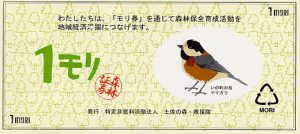Community currencies and local energy: an example from Japan
Community currencies are alternative forms of money that coexist with national or official currencies to cover the needs of a specific group or local area that the conventional monetary system is not addressing. Usually managed under a non-profit or social solidarity economy approach, community currencies showcase that money is a social creation, and that, as such, it can be rethought to address the inherent conflicts of the monetary system. Namely, traditional money is cycle-based and leading to scarcity (mortgage payers experience it painfully these days; think of the saying about how a banker is a fellow who lends you his umbrella when the sun is shining, but wants it back the minute it begins to rain); it also allows for monetary ‘leakage’ of impoverished regions (more money ‘leaks’ out of a community than is put in), and perpetuates inequalities (those in more need of liquidity, like low-income households and SMEs, are the first to suffer its scarcity). In addition to it all, with traditional money there is a complete absence of sustainability criteria in its creation and circulation. Indeed, the emission and contraction of the monetary offer is largely determined by an elite of private financial actors under for-profit criteria. This is translated in, for example, the fact that a polluting company could obtain credit as long as it shows capacity to repay it, or that traditional money can be used to buy virtually anything in equal conditions, no matter what the social or ecological impacts of the purchased good or service. That is why traditional money is also called “general-purpose money”, as opposed to “special-purpose money”, like community currencies.

Among many possible social and ecological purposes, these currencies can also serve as a catalyst of a collective territorial approach among different actors (local government, associations, citizens, companies, banks, etc). An inspiring example of it is presented by the researchers Miyazaki and Kurita (2018) who describe how, since the nuclear disaster of 2011, civil society in Japan has seen a rebirth of community currencies supporting self-sufficient local energy. The Kochi prefecture is a hilly forestry region with numerous volunteers’ associations for the sustainable management of the forest. The local non-profit organisation (NPO) Tosa No Mori Kyuentai is one of them and it has also created a regional self-sufficient energy system using the lumber from thinning the wood, which partly redistributes to regions devastated by the earthquake. To all this is added the issuance of a community currency, the MK coupons, to express ‘gratitude’ for volunteer foresting work and wood processing to create sustainable energy, and for national currency contributions from institutional and private partners. The MK can be spent in partner local shops, farms or fruit gardens across several municipalities in the region and is eventually redeemed at NPO Tosa No Mori Kyuentai. As the bases for an intra-regional economic system that uses local resources and a community currency, the non-profit is linking the preservation of traditional sustainable forestry, with the creation of sustainable energy from local resources and with the economic revitalization of the region.
For more information about community currencies and how to set one, see for example the guide People powered money by the New Economics Foundation.
Image:
MK note https://pds.exblog.jp/pds/1/201003/09/49/f0126949_1819389.jpg,
and forest volunteers group https://pds.exblog.jp/pds/1/201208/13/39/a0051539_6505482.jpg, credit NPO Tosa No Mori Kyuentai
Sources:
Miyazaki, Y. and Kurita, K.-I., 2018. Community currency and sustainable development in hilly and mountainous areas: A case study of forest volunteer activities in Japan, in: Monetary Plurality in Local, Regional and Global Economies. Routledge.
NPO Tosa No Mori Kyuentai https://mori100s.exblog.jp/i49/
